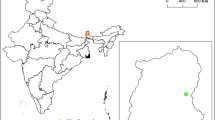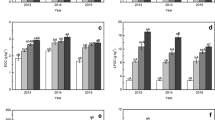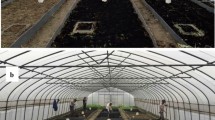Abstract
Application of biomass-derived low-cost biochar alter cropland soil’s ability to store organic carbon dynamics. At the ICAR-Sikkim Centre in Gangtok, India, a 10-year field experiment was conducted to investigate the effects of different organic manures (5.0 to 10.0 t ha−1) and maize biomass-derived low-cost biochar (pyrolysis temperature 600 °C) applications on soil carbon dynamics. The biochar was characterized by TEM, SEM, TGA, EDS, XRD, and FT-IR for morpho-mineralogical data. Different organic manures and maize biomass–derived biochar considerably enhanced soil carbon dynamics and pools. Low-cost biochar application at 2.5 t ha−1 significantly increased the very labile carbon followed by a decrease at 5 t ha−1. Manure with biochar delivered a huge impact on the active carbon pool as compared with manure without biochar. Biochar 5 t ha−1 + vermicompost 5 t ha−1 (23.41) augmented the passive carbon pool more than control (8.90) significantly. Besides, augmenting biochar addition rate in soil significantly reduced the lability index having a higher value with 2.5 t ha−1 than 5 t ha−1. Also, vermicompost 5 t ha−1 + biochar 5 t ha−1 (2.31) increased the carbon pool index significantly than the control. Interestingly, augmenting the low-cost biochar addition rate significantly enhanced the carbon management index. With the increase in days of incubation, the cumulative carbon mineralization of different biochars increased. Among the biochars, the highest % C mineralization of the initial TOC was found in black gram biochar. Data showed that the addition rate and type of biochar caused a considerable change in the decay constant. The mineralization quotient was more at a lower rate than the higher rate of biochar application. Our research conclusively established that in order to improve SOC dynamics and pools in the maize-black gram system in India’s northeastern regions, low-cost biochar technology is advised.








Similar content being viewed by others
Data availability
On request, the data will be available.
References
Al-Wabel MI, Hussain Q, Usman ARA, Ahmad M, Abduljabbar A, Sallam AS, Ok YS (2017) Impact of biochar properties on soil conditions and agricultural sustainability: a review. Land Degrad Dev 29(7):2124–2161
Das SK, Ghosh GK, Avasthe RK (2020) Application of biochar in agriculture and environment, and its safety issues. Biomass Convers Biorefin. https://doi.org/10.1007/s13399-020-01013-4
Bimbraw AS (2019) Generation and impact of crop residue and its management. Curr Agric Res J 7(3):303–309. https://doi.org/10.12944/CARJ.7.3.05
Fidel RB, Laird D, Thompson AML (2013) Evaluation of modified Boehm titration methods for use with biochars. J Environ Qual 42:1771–1778
Das SK, Ghosh GK, Avasthe RK (2021) Conversion of crop, weed and tree biomass into biochar for heavy metal removal and wastewater treatment. Biomass Convers Biorefin. https://doi.org/10.1007/s13399-021-01334-y
Cantrell KB, Hunt PG, Uchimiya M, Novak JM, Ro KS (2012) Impact of pyrolysis temperature and manure source on physicochemical characteristics of biochar. Bioresour Technol 107:419e428
Das SK, Ghosh GK (2022) Soil hydro-physical properties affected by biomass-derived biochar and organic manure: a low-cost technology for managing acidic mountain sandy soils of north eastern region of India. Biomass Convers Biorefin:1–15. https://doi.org/10.1007/s13399-022-03107-7
Case SDC, Mcnamara NP, Reay DS, Whitaker J (2014) Can biochar reduce soil greenhouse gas emissions from a Miscanthus bioenergy crop? GCB Bioenergy 6:76e89
Chapman HD (1965) Cation Exchange Capacity. In: Black CA (ed) Methods of Soil Analysis. American Society of Agronomy, Madison, pp 891–901
Das SK, Ghosh GK, Avasthe RK, Sinha K (2021) Compositional heterogeneity of different biochar: effect of pyrolysis temperature and feedstocks. J Environ Manage 278(2):111501. https://doi.org/10.1016/j.jenvman.2020.111501
Wang M, Zhu Y, Cheng L, Andserson B, Zhao X, Wang D, Ding A (2018) Review on utilization of biochar for metal-contaminated soil and sediment remediation. J Environ Sci 63(1):156–173
Das SK, Ghosh GK, Avasthe RK (2020) Biochar application for environmental management and toxic pollutant remediation. Biomass Convers Biorefin. https://doi.org/10.1007/s13399-020-01078-1
Collard F-X, Blin J (2014) A review on pyrolysis of biomass constituents: mechanisms and composition of the products obtained from the conversion of cellulose, hemicelluloses and lignin. Renew Sustain Energy Rev 38:594–608
Das SK, Avasthe RK, Singh M (2016) Carbon negative biochar from weed biomass for agricultural research in India. Curr Sci 110(11):2045–2046
Dias B, Silva C, Higashikawa F, Roig A, Sanchez-Monedero M (2010) Use of biochar as bulking agent for the composting of poultry manure: effect on organic matter degradation and humification. Bioresour Technol 10:1239–1246
Farina MPW, Channon P (1991) A field comparison of lime requirement indices for maize. Plant Soil 134:127–135
Das SK, Ghosh GK, Avasthe RK, Sinha K (2020) Morpho-mineralogical exploration of crop, weed and tree derived biochar. J Hazard Mater 407:124370. https://doi.org/10.1016/j.jhazmat.2020.124370
Gai X, Wang H, Liu J, Zhai L, Liu S, Ren T, Liu H (2014) Effects of feedstock and pyrolysis temperature on biochar adsorption of ammonium and nitrate. PLoS One 9:e113888
Cao X, Harris W (2010) Properties of dairy-manure-derived biochar pertinent to its potential use in remediation. Bioresour Technol 101(14):5222–5228
Das SK, Ghosh GK, Avasthe RK (2020) Ecotoxicological responses of weed biochar on seed germination and seedling growth in acidic soil. Environ Technol Innov 20:101074. https://doi.org/10.1016/j.eti.2020.101074
Leng L, Xu X, Wei L, Fan L, Huang H, Li J et al (2019) Biochar stability assessment by incubation and modelling: methods, drawbacks and recommendations. Sci Total Environ. https://doi.org/10.1016/j.scitotenv.2019.01.298
Das SK, Ghosh GK, Avasthe RK (2022) Valorizing biomass to engineered biochar and its impact on soil, plant, water and microbial dynamics: review. Biomass Convers Biorefin 12:4183–4199. https://doi.org/10.1007/s13399-020-00836-5
Hernandez-Mena L, Pecora A, Beraldo A (2014) Slow pyrolysis of bamboo biomass: analysis of biochar properties. Chem Eng Trans 37:115–120
Das SK, Ghosh GK, Avasthe R (2022) Biochar and organic manures on produce quality, energy budgeting, and soil health in maize-black gram system. Arab J Geosci 15:1527. https://doi.org/10.1007/s12517-022-10790-3
Jackson ML (1973) Soil chemical analysis. Prentice Hall of India Pvt. Ltd., New Delhi, p 498
Jankowska H, Swiatkowski A, Choma J (1991) Active carbon. Ellis Horwood, New York
Cely P, Gascó G, Paz-Ferreiro J, Méndez A (2015) Agronomic properties of biochars from different manure wastes. J Anal Appl Pyrolysis 111:173–182
Jindo K, Mizumoto H, Sawada Y, Sanchez-Monedero MA, Sonoki T (2014) Physical and chemical characterization of biochars derived from different agricultural residues. Biogeosciences 11(23):6613–6621
Singh M, Das SK, Avasthe RK (2018) Effect of multipurpose trees on production and soil fertility on large cardamom based agroforestry system in Sikkim Himalaya. Indian J Agrofor 20(2):25–29
Karim AA, Kumar M, Mohapatra S, Singh SK (2019) Nutrient rich biomass and effluent sludge wastes co-utilization for production of biochar fertilizer through different thermal treatments. J Clean Prod 228:570–579. https://doi.org/10.1016/j.jclepro.2019.04.330
Chen J, Wang P, Ding L, Yu T, Leng S, Chen J et al (2021) The comparison study of multiple biochar stability assessment methods. J Anal Appl Pyrolysis 156:105070. https://doi.org/10.1016/j.jaap.2021.105070
Kavitha B, Reddy PVL, Kim B, Lee SS, Pandey SK, Kim KH (2018) Benefits and limitations of biochar amendment in agricultural soils: a review. J Environ Manag 227:146–154
Khanmohammadi Z, Afyuni M, Mosaddeghi MR (2015) Effect of pyrolysis temperature on chemical and physical properties of sewage sludge biochar. Waste Manag Res 33:275e283
Das SK, Ghosh GK, Choudhury BU, Hazarika S, Mishra VK (2022) Developing biochar and organic nutrient packages/technology as soil policy for enhancing yield and nutrient uptake in maize-black gram cropping system to maintain soil health. Biomass Convers Biorefin. https://doi.org/10.1007/s13399-022-02300-y
Lehmann J, Joseph SM (2015) Biochar for environmental management: science and implementation, 2nd edn. Earthscan, London, p 997
Li S, Chen G (2018) Thermogravimetric, thermochemical, and infrared spectral characterization of feedstocks and biochar derived at different pyrolysis temperatures. Waste Manag 78:198–207
Liu CH, Chu W, Li H, Boyd SA, Teppen BJ, Mao J, Zhang W (2019) Quantification and characterization of dissolved organic carbon from biochars. Geoderma 335:161–169
Das SK, Mukherjee I (2014) Influence of microbial community on degradation of flubendiamide in two Indian soils. Environ Monit Assess 186(5):3213–3219
Zhang A, Cheng G, Hussain Q, Zhang M, Feng H, Dyck M, Wang X (2017) Contrasting effects of straw and straw–derived biochar application on net global warming potential in the Loess Plateau of China. Field Crops Res 205:45–54
Mukome FND, Zhang X, Silva LCR, Six J, Parikh SJ (2013) Use of chemical and physical characteristics to investigate trends in biochar feedstocks. J Agric Food Chem 61:2196–2204
Das SK (2019) Soil carbon sequestration strategies under organic production system: a policy decision. Agrica 8(1):1–6
Novak J, Ro K, Ok YS, Sigua G, Spokas K, Uchimiya S, Bolan N (2016) Biochars multifunctional role as a novel technology in the agricultural, environmental, and industrial sectors. Chemosphere 142:1–3
Das SK, Ghosh GK (2022) Conversion of biomass into low-cost biochar along with organic manure improved soil hydro-physical environment through technological intervention for sandy soil restoration. Biomass Convers Biorefin. https://doi.org/10.1007/s13399-022-02724-6
Prost K, Borchard N, Siemens J, Kautz T, Séquaris J, Amelung W (2012) Biochar affected by composting with farmyard manure. J Environ Qual 42(1):164–172
Das SK, Ghosh GK, Avasthe RK, Kundu MC, Choudhury BU, Baruah K, Lama A (2021) Innovative biochar and organic manure co-composting technology for yield maximization in maize-black gram cropping system. Biomass Convers Biorefin. https://doi.org/10.1007/s13399-021-01519-5
Ronsse F, van Hecke S, Dickinson D, Prins W (2013) Production and characterization of slow pyrolysis biochar: influence of feedstock type and pyrolysis conditions. GCB Bioenergy 5(2):104–115
Das SK, Choudhury BU, Hazarika S, Mishra VK, Laha R (2023) Long term effect of organic fertilizer and biochar on soil carbon-fractions and sequestration in maize-black gram system. Biomass Convers Bioref. https://doi.org/10.1007/s13399-023-04165-1
Leng L, Huang H, Li H, Li J, Zhou W (2019) Biochar stability assessment methods: a review. Sci Total Environ 647:210–222. https://doi.org/10.1016/j.scitotenv.2018.07.402
Stevenson FJ (1994) Humus chemistry: genesis, composition, reactions. John Wiley & Sons, New York, USA
Das SK, Ghosh GK (2021) Developing biochar-based slow-release N-P-K fertilizer for controlled nutrient release and its impact on soil health and yield. Biomass Convers Biorefin. https://doi.org/10.1007/s13399-021-02069-6
Subbiah BV, Asija GL (1956) A rapid procedure for the determination of available nitrogen in soil. Curr Sci 25:259–260
Das SK, Mukherjee I (2020) Low cost biomass derived biochar amendment on persistence and sorption behaviour of flubendiamide in soil. Bull Environ Contam Toxicol 105:261–269. https://doi.org/10.1007/s00128-020-02936-4
Veihmeyer FJ, Hendrickson AH (1948) The permanent wilting percentage as a reference for the measurement of soil moisture. Trans Am Geophys Union 29. https://doi.org/10.1029/TR029i006p00887
Das SK, Ghosh GK (2021) Hydrogel-biochar composite for agricultural applications and controlled release fertilizer: a step towards pollution free environment. Energy 242:122977. https://doi.org/10.1016/j.energy.2021.122977
Mukherjee A, Zimmerman AR (2013) Organic carbon and nutrient release from a range of laboratory-produced biochars and biochar-soil mixtures. Geoderma 193:122–130
Das SK, Ghosh GK (2021) Development and evaluation of biochar based secondary and micronutrient enriched slow release nano-fertilizer for reduced nutrient losses. Biomass Convers Biorefin. https://doi.org/10.1007/s13399-021-01880-5
Yargicoglu EN, Sadasivam BY, Reddy KR, Spokas K (2015) Physical and chemical characterization of waste wood derived biochars. Waste Manag 36:256–268
Das SK, Ghosh GK, Avasthe RK (2020) Evaluating biomass-derived biochar on seed germination and early seedling growth of maize and black gram. Biomass Convers Biorefin. https://doi.org/10.1007/s13399-020-00887-8
Das SK, Ghosh GK, Avasthe RK (2017) Biochar amendments on physico-chemical and biological properties of soils. Agrica 6(2):19–27
Leng L, Huang H (2018) An overview of the effect of pyrolysis process parameters on biochar stability. Bioresour Technol. https://doi.org/10.1016/j.biortech.2018.09.030
Yuan H, Lu T, Huang H, Zhao D, Kobayashi N, Chen Y (2015) Influence of pyrolysis temperature on physical and chemical properties of biochar made from sewage sludge. J Anal Appl Pyrolysis 112:284e289
Zhao L, Cao X, Masek O, Zimmerman A (2013) Heterogeneity of biochar properties as a function of feedstock sources and production temperatures. J Hazard Mater 256:1–9
Das SK, Ghosh GK, Avasthe RK (2021) Applications of biomass derived biochar in modern science and technology. Environ Technol Innov 21:101306. https://doi.org/10.1016/j.eti.2020.101306
Singh M, Gupta B, Das SK (2018) Soil organic carbon (SOC) density under different agroforestry systems along an elevation gradient in North-Western Himalaya. Range Manag Agrofor 39(1):8–13
Acknowledgements
The author is very thankful to ICAR RC for NEH Region, Umiam, Meghalaya, for providing the necessary research facilities.
Funding
The author received funds from the “National Innovations in Climate Resilient Agriculture (NICRA).”
Author information
Authors and Affiliations
Contributions
Shaon Kumar Das: comprehensive research work, data analysis and interpretation, writing of the article, and final interpretation.
Corresponding author
Ethics declarations
Ethical approval
NA
Competing interests
The authors declare no competing interests.
Additional information
Publisher’s Note
Springer Nature remains neutral with regard to jurisdictional claims in published maps and institutional affiliations.
Rights and permissions
Springer Nature or its licensor (e.g. a society or other partner) holds exclusive rights to this article under a publishing agreement with the author(s) or other rightsholder(s); author self-archiving of the accepted manuscript version of this article is solely governed by the terms of such publishing agreement and applicable law.
About this article
Cite this article
Das, S.K. Soil carbon footprint, budgeting, and dynamics in a biomass conversion–based long-term organic production system. Biomass Conv. Bioref. (2023). https://doi.org/10.1007/s13399-023-04646-3
Received:
Revised:
Accepted:
Published:
DOI: https://doi.org/10.1007/s13399-023-04646-3




